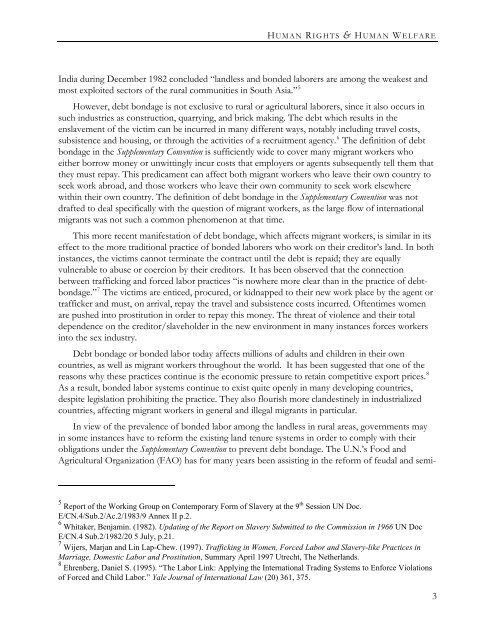Slavery in The 21st Century
Slavery in The 21st Century
Slavery in The 21st Century
You also want an ePaper? Increase the reach of your titles
YUMPU automatically turns print PDFs into web optimized ePapers that Google loves.
H UMAN R IGHTS & HUMAN W ELFARE<br />
India dur<strong>in</strong>g December 1982 concluded “landless and bonded laborers are among the weakest and<br />
most exploited sectors of the rural communities <strong>in</strong> South Asia.” 5<br />
However, debt bondage is not exclusive to rural or agricultural laborers, s<strong>in</strong>ce it also occurs <strong>in</strong><br />
such <strong>in</strong>dustries as construction, quarry<strong>in</strong>g, and brick mak<strong>in</strong>g. <strong>The</strong> debt which results <strong>in</strong> the<br />
enslavement of the victim can be <strong>in</strong>curred <strong>in</strong> many different ways, notably <strong>in</strong>clud<strong>in</strong>g travel costs,<br />
subsistence and hous<strong>in</strong>g, or through the activities of a recruitment agency. 6 <strong>The</strong> def<strong>in</strong>ition of debt<br />
bondage <strong>in</strong> the Supplementary Convention is sufficiently wide to cover many migrant workers who<br />
either borrow money or unwitt<strong>in</strong>gly <strong>in</strong>cur costs that employers or agents subsequently tell them that<br />
they must repay. This predicament can affect both migrant workers who leave their own country to<br />
seek work abroad, and those workers who leave their own community to seek work elsewhere<br />
with<strong>in</strong> their own country. <strong>The</strong> def<strong>in</strong>ition of debt bondage <strong>in</strong> the Supplementary Convention was not<br />
drafted to deal specifically with the question of migrant workers, as the large flow of <strong>in</strong>ternational<br />
migrants was not such a common phenomenon at that time.<br />
This more recent manifestation of debt bondage, which affects migrant workers, is similar <strong>in</strong> its<br />
effect to the more traditional practice of bonded laborers who work on their creditor’s land. In both<br />
<strong>in</strong>stances, the victims cannot term<strong>in</strong>ate the contract until the debt is repaid; they are equally<br />
vulnerable to abuse or coercion by their creditors. It has been observed that the connection<br />
between traffick<strong>in</strong>g and forced labor practices “is nowhere more clear than <strong>in</strong> the practice of debtbondage.”<br />
7 <strong>The</strong> victims are enticed, procured, or kidnapped to their new work place by the agent or<br />
trafficker and must, on arrival, repay the travel and subsistence costs <strong>in</strong>curred. Oftentimes women<br />
are pushed <strong>in</strong>to prostitution <strong>in</strong> order to repay this money. <strong>The</strong> threat of violence and their total<br />
dependence on the creditor/slaveholder <strong>in</strong> the new environment <strong>in</strong> many <strong>in</strong>stances forces workers<br />
<strong>in</strong>to the sex <strong>in</strong>dustry.<br />
Debt bondage or bonded labor today affects millions of adults and children <strong>in</strong> their own<br />
countries, as well as migrant workers throughout the world. It has been suggested that one of the<br />
reasons why these practices cont<strong>in</strong>ue is the economic pressure to reta<strong>in</strong> competitive export prices. 8<br />
As a result, bonded labor systems cont<strong>in</strong>ue to exist quite openly <strong>in</strong> many develop<strong>in</strong>g countries,<br />
despite legislation prohibit<strong>in</strong>g the practice. <strong>The</strong>y also flourish more clandest<strong>in</strong>ely <strong>in</strong> <strong>in</strong>dustrialized<br />
countries, affect<strong>in</strong>g migrant workers <strong>in</strong> general and illegal migrants <strong>in</strong> particular.<br />
In view of the prevalence of bonded labor among the landless <strong>in</strong> rural areas, governments may<br />
<strong>in</strong> some <strong>in</strong>stances have to reform the exist<strong>in</strong>g land tenure systems <strong>in</strong> order to comply with their<br />
obligations under the Supplementary Convention to prevent debt bondage. <strong>The</strong> U.N.’s Food and<br />
Agricultural Organization (FAO) has for many years been assist<strong>in</strong>g <strong>in</strong> the reform of feudal and semi-<br />
5 Report of the Work<strong>in</strong>g Group on Contemporary Form of <strong>Slavery</strong> at the 9 th Session UN Doc.<br />
E/CN.4/Sub.2/Ac.2/1983/9 Annex II p.2.<br />
6 Whitaker, Benjam<strong>in</strong>. (1982). Updat<strong>in</strong>g of the Report on <strong>Slavery</strong> Submitted to the Commission <strong>in</strong> 1966 UN Doc<br />
E/CN.4 Sub.2/1982/20 5 July, p.21.<br />
7 Wijers, Marjan and L<strong>in</strong> Lap-Chew. (1997). Traffick<strong>in</strong>g <strong>in</strong> Women, Forced Labor and <strong>Slavery</strong>-like Practices <strong>in</strong><br />
Marriage, Domestic Labor and Prostitution, Summary April 1997 Utrecht, <strong>The</strong> Netherlands.<br />
8 Ehrenberg, Daniel S. (1995). “<strong>The</strong> Labor L<strong>in</strong>k: Apply<strong>in</strong>g the International Trad<strong>in</strong>g Systems to Enforce Violations<br />
of Forced and Child Labor.” Yale Journal of International Law (20) 361, 375.<br />
3

















